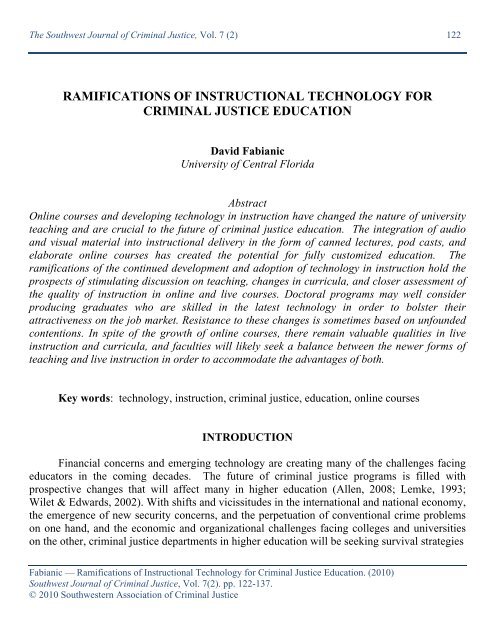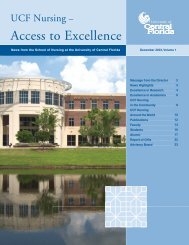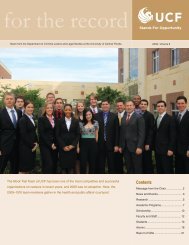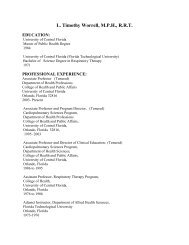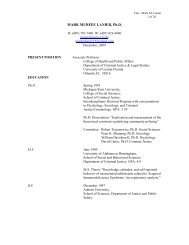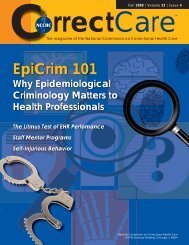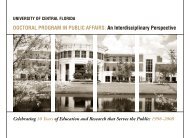Fabianic Article (1).pdf - swacj
Fabianic Article (1).pdf - swacj
Fabianic Article (1).pdf - swacj
You also want an ePaper? Increase the reach of your titles
YUMPU automatically turns print PDFs into web optimized ePapers that Google loves.
The Southwest Journal of Criminal Justice, Vol. 7 (2) 122RAMIFICATIONS OF INSTRUCTIONAL TECHNOLOGY FORCRIMINAL JUSTICE EDUCATIONDavid <strong>Fabianic</strong>University of Central FloridaAbstractOnline courses and developing technology in instruction have changed the nature of universityteaching and are crucial to the future of criminal justice education. The integration of audioand visual material into instructional delivery in the form of canned lectures, pod casts, andelaborate online courses has created the potential for fully customized education. Theramifications of the continued development and adoption of technology in instruction hold theprospects of stimulating discussion on teaching, changes in curricula, and closer assessment ofthe quality of instruction in online and live courses. Doctoral programs may well considerproducing graduates who are skilled in the latest technology in order to bolster theirattractiveness on the job market. Resistance to these changes is sometimes based on unfoundedcontentions. In spite of the growth of online courses, there remain valuable qualities in liveinstruction and curricula, and faculties will likely seek a balance between the newer forms ofteaching and live instruction in order to accommodate the advantages of both.Key words: technology, instruction, criminal justice, education, online coursesINTRODUCTIONFinancial concerns and emerging technology are creating many of the challenges facingeducators in the coming decades. The future of criminal justice programs is filled withprospective changes that will affect many in higher education (Allen, 2008; Lemke, 1993;Wilet & Edwards, 2002). With shifts and vicissitudes in the international and national economy,the emergence of new security concerns, and the perpetuation of conventional crime problemson one hand, and the economic and organizational challenges facing colleges and universitieson the other, criminal justice departments in higher education will be seeking survival strategies<strong>Fabianic</strong> — Ramifications of Instructional Technology for Criminal Justice Education. (2010)Southwest Journal of Criminal Justice, Vol. 7(2). pp. 122-137.© 2010 Southwestern Association of Criminal Justice
123 <strong>Fabianic</strong> — Instructional Technology (2010)just as vigorously as other academic departments with which they will compete for scarceresources. In this climate of transformation, an important ingredient will be the escalatinginstructional technology which will provide one of the tools to use to contend with the problemsassociated with academic maturation in the next few decades (Gumport & Chun, 1999). It isprudent to anticipate the possible ramifications for criminal justice education that emerginginstructional technology and the associated applications represent. Much of the future ofcriminal justice systems will be shaped and influenced by those passing through criminal justiceeducation programs and consequently the structure of that enterprise is crucial. The largeenrollment environment is one place where technology has had a significant impact as far asserving numbers is concerned and consequently that is the primary setting for the ruminationsthat follow. The thoughts and observations are offered by one who had been teaching for overforty years in small and large enrollment environments, and has taught online courses duringthe last fourteen years. Most of the following discussion will focus on online instruction anddelivery although the observations offered may apply more broadly in many instances.Technology, broadly interpreted here includes online courses, video presentations,canned lectures, and the use of pedagogical tools such as Tegrity, has provided a learningenvironment that practically mirrors the large, traditional lecture hall and creates a virtualclassroom. Although not all universities are at the same level of development and accessibility,today it is possible to create audio-visual presentations of class lectures and demonstrations, andmuch more (Hesel, 1992; Matthews, 1999). This might involve the inclusion of professionallyor self produced DVDs; integration of audio-visual materials into classroom and onlinepresentations; canned video lectures; expanded use of web instructional tools; clickers; or otherstrategies for delivering information or engaging students (Boulos, Hetherington & Wheeler,2007). One can prepare a refined presentation that exceeds the normal features of the traditionallecture. The technology to create such presentations is available and will likely improvedramatically in the next ten years so that complete interaction and instant communicationbetween faculty and student via the internet are available.For many faculty members today, instructional technology begins with online instruction.Several years ago, online instruction was advanced and represented the cutting edge of teachingtechnology (Allen & Seaman, 2006; Kriger, 2001). Today it represents the first primitive stepinto the future. What lies beyond the conventional posting of lectures, other written materials,and assignments to be submitted online is a significant transformation of the way facultymembers do their jobs and the rational for doing it. The new technological forms will havesignificant consequences for structural features such as curricula and department organization.There are signs that this development is currently in progress. Online instruction is a given facton most campuses today to the extent that some programs and universities exist entirely online.There are several compelling reasons that suggest the inevitability of advanced technologicalsophistication in instruction or explain its presence. The first is that technology is continuing toexpand regardless of what use educational institutions may find for it. The world of electronicgadgetry is here with cell phones, I-pods, clickers, portable GPS systems and countless software
The Southwest Journal of Criminal Justice, Vol. 7 (2) 124programs of all sorts for innumerable purposes. Higher education, like any other institution insociety, tends to take what hammers are available and then go looking for nails to hit. There isa group among the teaching ranks in higher education that places emphasis on style whileignoring substance. It cannot resist the temptation of technological gadgetry and this group willfeel compelled to indulge itself, simply because the toys are there.In addition, it is important to recognize that today’s students are generally well equippedto utilize these mechanisms. They have been socialized in a culture populated by electronicdevices and they have become relatively facile in their uses. Students are able to communicatewith others using this equipment and many students now favor electronic communicationinstead of face-to-face interaction. Putting the faculty who favor electronic delivery with acapable student constituency means that this form of instruction is well received by a substantialnumber of students.The second reason is more pragmatic in that technology will be portrayed to befinancially beneficial (Twigg, 2003). Universities, acting in what they think is their bestinterests, will adopt the new technology because they perceive it to be financially advantageousto do so. More and more courses and curriculum concerns will be driven by the presence oftechnology. Universities whose resources and facilities are impacted heavily by an increasingstudent population can find some relief in online instruction. Online instruction will not onlyhelp to enroll widely dispersed student constituencies that cannot otherwise be reached, but itwill also facilitate accommodation by reducing pressure for additional classroom space,dormitory rooms, etc. of on-campus students This enrollment is critical for those institutionsand programs that depend on student numbers for survival. Criminal justice courses andprograms would appear to be one of the prime beneficiaries of this possibility. One of the mainconstituencies for criminal justice programs are practitioners in law enforcement, corrections, orthe judicial system, and the ability to enhance educational credentials through online programsis appealing to fulltime, working personnel.The emergence of technology and the necessity for financial prudence assures that thedevelopments and innovations in educational delivery will continue. That being the case, whatdoes it mean for university level education in general and criminal justice education inparticular? Given that web courses and other newer forms of instruction are rapidlyproliferating with important consequences for criminal justice programs, it would be wise toconsider several primary aspects of the emerging technology and to speculate about what maybe anticipated for criminal justice educators.CONSEQUENCES AND RAMIFICATIONSAssuming that criminal justice departments accept the inevitable, at least in principle,there are some immediate consequences that will be felt by academic departments as severalfactors converge producing results that if ignored may be detrimental. First, the technologyexpansion itself will call for more technical support. Departments may very well become
125 <strong>Fabianic</strong> — Instructional Technology (2010)obligated to make budgetary provisions for a fulltime technical support person. The need forsuch a person will depend on the scale of involvement an academic unit chooses to pursue andthe level of capability of the faculty members involved. As this issue is advanced, there will bequestions raised concerning whether or not these services should be centralized ordecentralized, matters that will have to be determined by the context in which they appear andthe local political winds.A second consequence will center on becoming able to compete. As more and moreprograms go online, the competition for students will escalate. Traditional universities anddepartments will be challenged by for-profit programs on the internet. The brick and mortarschools will try to develop incentives for students to enroll in their respective programs. Thoseincentives may be financial ones, the appeal of the web, the strength of institutional reputation,or the appearance of the “easier” curricula. The convenience of online instruction is a stronginducement and most certainly will be heavily emphasized. Students will seek alternatives tothe very expensive, traditional college or university and search for the options that provideconvenience and economy. The shortened, web-based program will appeal to this group.Third, the national trend toward the reduction of fulltime, tenure earning faculty willcontinue. By using large enrollment online courses, more students will be able to be servedmore easily, and the need for fulltime teaching faculty, while not disappearing, will diminishslightly (Parry, August 14, 2009). (This does not necessarily mean a significant loss of fulltimefaculty; critical instructional needs and the research obligation of the department will continuerequire fulltime staffing.) The reduction in tenure track positions will be assisted by publishersand independent entrepreneurs who will begin offering electronic packages for courses, if notfor programs, thus reducing the need for a high number of fulltime faculty positions devoted toteaching large sections of undergraduates. Once these instructional packages are purchased,they need only to be administered.Given this possibility, it is important to note that the same market parameters that nowgovern the publishing industry will prevail in the promotion of these instructional packages.This means that there will be a tendency to drift toward the least common denominator in termsof the quality and rigor imposed, and there will be strong competition in the market to promoteand sell the products. It is also likely that if the electronic packages are like textbooks, they willundergo frequent revisions requiring their purchase in order to remain current. Publishers willtilt toward “dressing up” the product with a lot of bells, whistles and pretty pictures at theexpense of content, while still charging a husky fee. Accompanying this will be a change inmarketing strategies employed by publishers. Just as the textbooks for various courses are takento reflect the quality of some courses, the adoption of instructional packages will be taken as anindicator of the quality of instruction provided by the faculty person. One possible result of thisprocess could be the production and distribution of canned or packages courses which if createdby nonprofessionals might be filled with inaccuracies. As publishing groups assume theobligation for generating technology for teaching, it is possible that they may take on facultypersons as fulltime time authors to assist in the writing and development of their products.Among other things, the curriculum will likely be altered and the role of the faculty member
The Southwest Journal of Criminal Justice, Vol. 7 (2) 126may change to include writing specifically for online learning. As a result of all this, at the veryleast questions will be raised about the level of quality of the packages being offered, andcurriculum reviews and oversight will be difficult in the future.One related result of the scrutiny to which online and canned courses will be subjectedwill be an effect on live courses offerings. As questions are raised about the quality of electronicofferings and the faculty labor invested in them, it will be logical to ask the same questionsabout existing live courses to determine whether or not they are of sufficient quality. The urgeto expose lazy faculty who are abusing online courses will quite likely expand in application toall forms of instruction. This will make some people very uncomfortable and in the effort toestablish some form of quality control there are likely to be critical discussions about the natureof teaching, conversations that would not otherwise transpire.A fourth consequence is the likelihood that the technological imperative will also impactcurricula in doctoral programs and the hiring process for newly minted PhDs. The prospects forthe future role of the university criminal justice instructor will be the same as for any similardiscipline that is strong on lecture technique and less concerned with laboratory instruction.The challenge may be addressed at either the individual or departmental level, or somecombination of the two. At the individual level, when new hires are made, departments may belooking for technical pedagogical skills in addition to knowledge of the discipline and theability to conduct research. A possible item included in future hiring materials may be aproficiency in the “canned” performance of the applicant in which he/she demonstrates masteryof current, cutting-edge instructional tools. Department hiring authorities may be askingapplicants if they possess the requisite technical knowledge to be able to contribute to theinstructional profile of the department, and this may include the abilities to teach online coursesat a minimum, or perhaps work in a more advanced technological medium. If this situationtranspires, doctoral programs will become obligated to offer some educational strategies toassist their graduates to become competitive in this area, as they sometimes do with PowerPointand other graphic presentations programs. Consequently, we may witness an addition to thecore curriculum, one that addresses this aspect of preparation. Doctoral programs may actuallybegin to teach their students how to teach.A fifth impact, related to the preceding ones, is an additional dimension along whichfaculty members will become stratified. In many departments, there already exist numerousfactors that divide faculty members into various groups, such as rank, research interests,quantitative skills, graduate teaching, grantsmanship, etc. The ability to adopt and managesuccessfully various forms of new teaching techniques could provide one more factor by whichfaculty members will draw distinctions among themselves. This would become more importantat the teaching institutions but it would still remain significant at research universities as well.
127 <strong>Fabianic</strong> — Instructional Technology (2010)SPECIAL CHALLENGE TO THE STATUS QUOThe preceding ramifications all assume a degree of utilization of newer technologicalforms for instruction. There are several ramifications of new instructional technology thatprecede the acceptance of these innovations. A major consequence of new technology onteaching and the traditional ways of delivering information will be the challenge to conventionalinstruction and resulting faculty reaction. It is important to consider this challenge furtherbecause it is critical to the development of technological instructional tools. For many years,the gold standard for instruction has been the live, face-to-face setting in the classroom with asmall number of students. The reality for many departments in higher education, particularlythose with large enrollments, is that Mr. Chips left the building a long time ago. Instructionalstyle has transitioned from the small, intimate classroom to free form web courses that featuremostly text and email; to early web courses through Blackboard and WebCT; to narratedPowerPoint integrated into web courses; to audio and video attached to files; to canned videolectures or presentations. Each of these stages has brought us closer to complete simulation ofthe live classroom. What is now possible are full lectures that can be taped and viewed at anytime supplemented by a variety of technological tools to support this initiative. In addition,students can communicate “face to face” with a video camera thus providing interaction. Thiscomes very close to the current experience of a student in a large class listening to a lecture.Add to that the ability to download a presentation and carry it around on an IPod and there aresome clear advantages to the new technology.With advancing technology, significant problems are likely to emerge at the faculty leveland one such question concerns the future role of the faculty member. Even with the early formsof web instruction, there were fears expressed of “faculty obsolescence.” This apprehension isrepresented in the notion that online courses would somehow render faculty members lessmeaningful or useful. Some apprehensions included speculation that faculty personnel wouldbegin to completely disappear and would no longer be needed. This has not happened and theseconcerns have perhaps persisted due to the financial crisis facing higher education andsubsequent hiring freezes and layoffs. In the current financial climate, there will be an increasedinitiative from university administrations to economize course offerings and to seek mostproduction for the least investment, while offering the appropriate words to rationalize anddefend the quality of what remains to be taught (Milam, 2010; Perez, 2009; Twigg, 2003). Thelatter is a matter of manipulating the smoke and mirrors, and most administrations are good atthat.As new instructional techniques merge with traditional pedagogical forms, resistance tochange on the part of some faculty can be expected (Johnson, Aragon, Shaik & Palma-Rivas,2000). The acceptance of online teaching, or other forms of instruction using cutting edgetechnology, has not been universal and there remain many objections and resistance to thesenew forms as they grow and develop. At the department level, it may be there are too many olddogs to which new tricks cannot be taught. The objections they typically raise include a
The Southwest Journal of Criminal Justice, Vol. 7 (2) 128mistrust of the web, loss of face time with students, aversion to technology in general, lack oftechnical support, and other problems which they contend are difficult if not impossible toresolve (Dobbs, Waid, & del Carmen, 2009).The presence of someone to perform the technical portions of the task as well as lead thefaculty gradually to the new form of teaching and learning might ease some discomfortattendant the technical concern. This is problematic to an extent because given budgetconstraints, funding for such a position would likely come at the expense of a faculty position,something that most departments would seek to avoid. In addition, making the technician rolecompatible with faculty personnel may prove awkward.The reluctance of some faculty to adopt the newer forms of delivery is understandable,but some of the arguments used to resist change and justify the status-quo are not sound. Someprogress in persuading reluctant faculty is perhaps possible if a few of the myths about onlineteaching are confronted directly. For example, there are at least two substantial concerns oftenaired by those who oppose online courses, and by extension other less conventional forms ofinstruction. The first is the loss of “face-time” with students. Face-time is that time duringwhich teacher and student interact in person and are actually communicating with each otherface-to-face. The second is the prospect of cheating and plagiarism.THE VALUE OF FACE-TO-FACE INTERACTIONAmong the things that online teaching should require of participating faculty areexaminations of what teaching is, what is expected from the students, what is expected from theteacher, and an assessment of availability of resources to support online instruction. For somefaculty members, their aversion to online instruction or canned lectures rests with the belief thatthe live classroom setting is sacred ground upon which a unique dynamic of learning transpires.For them, this dynamic can only occur in the environment of face-to-face meeting with students(Parry, August 14, 2009; Shieh, 2009; Witta, 2005; Young, 2002). No doubt this is correct insome instances, particularly classes with low enrollments. Another perspective emerges uponclose examination of conventional lectures delivered to classes with large enrollments. Thereality is that for many large enrollment classes employing lectures, face-time instruction hasbecome rote and routine, often each class very much like another one, and never straying too farfrom the traditional approach of the teacher in front of the classroom reciting the day’s lecturefrom slightly worn pages. Even if the faculty member has advanced to the use of PowerPointdisplays, often the displays rarely change and only put up on a screen the tired old notes fromyears’ past. There are several reasons why this pattern is as common as it is. Faculty memberscan exist comfortably embracing this style because it is safe; requires little work and noinnovation; and easily passes as acceptable. Students and others perceive this style to be thetraditional classroom and when they experience it they are convinced they are getting what theyexpected to receive. The professor is seen as the fountain of knowledge and the students areregarded as vessels that need to be filled with wisdom. The students play the role of passive
129 <strong>Fabianic</strong> — Instructional Technology (2010)learners primarily interested in getting through the course with an acceptable grade. Thisapproach discourages genuine critical thinking, challenges to conventional wisdom, anddevelopment of independent thought and expression. None of these consequences shouldsurprise any faculty member who teaches large enrollment classes because this approach toaddress large numbers of students is structured to produce those discouraging results. In suchcircumstances, neither the professor nor the students are very interested in anything beyondgetting through the term by clearing the not too high hurdles that include several examinationsand perhaps another assignment or two. Most instruction in the large, overcrowded classroomsfilled with undergraduates begins with this model or some variant of it.In spite of these characteristics of the large lecture, one of the first expressions of concernoften uttered by those who resist online teaching is that the face-to-face classroom is betterbecause it leads to teacher “getting to know” their students better, and leads to bettercommunication. Sometimes it is claimed that the online courses lack the “human” element andthat this is what is valuable in live courses. There is no question that there are contrastsbetween live and online courses, and that one of the many points of difference is the absence of“live,” face-to-face interaction between the students and the instructor. The claim that the facetimeapproach is superior due to the connection between students and teacher is questionableand warrants closer examination.Keeping in mind that the form of instruction under consideration here is large enrollmentundergraduate courses that do not involve significant or substantial mathematics or statistics,the claim that the teacher in the live class gets to know the student better than does the onlineinstructor can be challenged. To begin with, teachers in large, live classes rarely get to knowany more than a handful of their students, and few of those connections go beyond name andface recognition. Large classes do not lend themselves to significant familiarity betweenstudent and teacher. There are exceptions here and there across the educational landscape ofteachers who make a point to learn the names of all the students in their classes of 100 or more,and learn to identify them sufficiently to be able to call on them in class. These herculeanefforts are very rare, and even then there remains the question of how well the teacher knowsthe students beyond their names. The truth is that most teachers of large enrollment classesbecome acquainted with only a small number of students as they present themselves in class.When questions are solicited or discussions pursued in class, normally there are a handful ofstudents who are willing to participate. The instructor becomes acquainted with these people toa limited degree, but not much more than the rest of the class many of whom are very reluctantto speak out in a class setting.By comparison, the online teacher may be in a better position to draw out responses tostudents by engaging students in online discussions. Discussion boards in online courses permitstudents to draft thoughtful responses and to examine the responses of others carefully beforereplying. Likewise instructors can carefully craft statements to post to respond to students’thoughts. Students learn there is less risk of embarrassment posting a message on a discussionboard than speaking in class. As a result, the online teacher is probably able to reach morestudents in a significant way than the teacher in the live classroom setting. Many of those
The Southwest Journal of Criminal Justice, Vol. 7 (2) 130students who would never participate in a live class discussion will contribute to onlinediscussions and do so consistently throughout the term. To the extent that these discussionsinform the teacher about the student, the online instructor is at least as well if not betterinformed about students than the instructor of the live course.If the value of face-to-face instruction is to be found in the discovery and awareness ofpersonal circumstances or the reading of cues related to understanding the course information,again the online course has something to offer as well. Being removed from the face-to-faceform of interaction, students who may otherwise be inhibited from interacting are much morelikely to express themselves about all sorts of things once they are able to do so online. There isa veil of semi-anonymity associated with posting a message online. The work of the studentand the students’ names are on the messages, but there is some electronic distance betweenthemselves and others who are reading the messages. This space or distance is what contributesto the reduction of reticence for the shy or reluctant student allowing them to become morelikely to participate. There is not as much fear of rejection or apprehension of being wrong infront of an instructor who is looking directly at you, not to mention a classroom filled with otherstudents. To some extent, it was this problem many years ago that lead to the adoption of thediscussion group format for some large survey courses. Faced with increasing enrollments,some departments turned to large lecture classes numbering in the hundreds and provided thepersonal contact with graduate teaching assistants to lead smaller groups of 12 to 15 studentsonce a week in discussion groups. The idea was to use these smaller group meetings to providethe personal value that was absent the large lecture hall approach. How well this worked as apedagogical device is debatable. Nonetheless, faculty who oppose online courses or theemerging forms of instruction driven by technology on the grounds that the face-to-faceexperience in a large lecture setting affords a special and unique bond with the teacher do nothave an unassailable argument.Still, there is something intrinsically valuable in a small, live class where the facultymember is a teacher as opposed to a lecturer. The value of this form is in the nature of humaninteraction, the ability to see and react to subtle communication cues, the necessity andopportunity to respond and express thoughts verbally, quickly. It is learning the subtleties ofspeech and learning to read the expressions of others. It is learning that people responddifferently when before an audience than when by themselves. It is realizing that once twopeople are engaged in an interaction, a new product is created that is more than the sum of itsparts. This more personal form is that in which much of our interaction and communicationtakes place in institutional settings, it is the way much business is conducted, and it is theprevailing method of social discourse. One of the more valuable assets of live instruction incriminal justice is that it is a way to communicate and socialize students into one of its severalprofessions (Hundersmarck, 2009). This is the result of interacting with a large number ofpeople face-to-face and observing and practicing the standards of the profession. It is learningverbal communication and interaction skills contributing to the ability to manipulate conceptsand elaborate them in communication with others; and immerse oneself in the discipline and
131 <strong>Fabianic</strong> — Instructional Technology (2010)discuss matters germane to professional interests. When a student takes an online course, theydo not receive this exact experience. There are compensatory virtues to be sure, but they do notreplace that which is missing.Are these features necessary? Do we really require these experiences in order to producea well educated criminal justice student? That is a question that confronts faculty in general andespecially those who teach the online courses and those that design curricula for academicprograms. It is clear that while online courses and other newly developed instructional formsare administratively expedient and also provide a valuable asset to a curriculum, they should notnecessarily be the only form of educational experience required of every student in spite of thegrowing use of advanced technology in instruction. The issue may not be that one must embraceeither online or live instruction, adopting one at the exclusion of the other. While large facetimeclasses do not impart the qualities valued by those that support face-time instruction, astrong argument can be made that small enrollment face-time classes do. If there is significantvalue in these classes, degree programs should consider requiring a modicum of live, smallenrollment classroom experiences. In addition, a requirement for all students to take someminimum number of online courses should be considered. It is abundantly clear that onlineinstruction, and the new emerging forms of technology will continue to expand their roles indelivering instruction and a substantial amount of learning in the future will take place usingthese techniques. The well educated student will have to know how to negotiate these learningopportunities in order to continue learning. This experience will be valuable criminal justicesystems employees who seek additional education or training while remaining fully employed.Therefore, academic programs such as criminal justice must come to recognize thatalthough administratively pleasing and fiscally prudent, online and high tech programs havelimits as far as academic merit is concerned. Maintaining exclusively online programs maybeterribly convenient for students and administrators, but it is not necessarily in the students’ bestinterests. Deployment of nontraditional forms of education will mean changes in the ways inwhich departments and faculty members do their jobs and organize themselves. On the otherhand, there is no reason for faculty members to continue to resist online instruction based on thenotion that large enrollment face-time courses are providing something so valuable as to justifya reluctance to accept the newer instructional technology. On the other hand, there are strengthsand specific elements that are unique to small enrollment live classes which make them a valuedexperience as well.CHEATING AND PLAGIARISMA second major misgiving that is often cited by critics of nontraditional instruction isplagiarism and cheating, particularly on examinations (Lanier, 2006). Perhaps there is no placewhere the difference between live and online instruction more is evident than in the process ofexaminations. The standard testing procedure in the live class is the instructor carrying someprinted exams into the classroom, distributing the exam, and announcing the time limit, perhaps
The Southwest Journal of Criminal Justice, Vol. 7 (2) 132even putting the time on the white or black board, and collecting the exams at the conclusion ofthe period. There are some variations on this theme, but essentially the instructor is present tomonitor the proceedings and can witness the students taking the exams. Taking exams onlinecreates more opportunities for cheating and plagiarism, a major concern among many who teachonline and definitely a point that is cited by those who refuse to accept online teaching aslegitimate. Aside from the classes which require students to appear at a specific location at aspecific time in order to take their examinations, or perhaps the small enrollment classes thatcan enjoy the luxury of substantial essay questions, the online situation is generally different,and the difference creates the necessity for further reflection concerning the nature and meaningof teaching as well as the strategies that are employed to evaluate performance. In the simplestform, as the one described above, online students will not be present at a common locationduring a specific time period. However, online exams are usually not administered at a singlelocation because to do so would defeat one of their prime objectives, namely, to reach studentswho are dispersed geographically. Rather the students will be dispersed over a larger area andthe time period may be very expansive. Students in this setting are generally not monitored andthat in turn opens the possibility for plagiarism and cheating. Faculty are fearful, with goodreason, that students will not do their own work on the other end of the exam, or they are fearfulthey will busy themselves finding the answers to questions by consulting outside sources.There is ample justification for these fears. The questions raised by this fact include assessinghow much difference this makes, and what can be done to minimize it.That being said, this challenge demands that the process of testing students online mustbe carefully considered. First, it must be acknowledged that plagiarism and cheating occur inmost modes of instruction. The live class has its share of errant test takers in the form of“ringers,” crib-note carriers, and “copy-directly-from-someone-else” type cheaters. Added tothat list are those who cheat by texting for answers. Thus, this form of misbehavior is notunique to online students. All instructors must come to grips with a single fact: Some studentswill cheat if you give them a chance. The problem in online courses is that if the instructor isgoing to use the conventional examination process, he/she must first accept that this is going tohappen. The instructor must think of ways to make it difficult for students to accomplish this,develop strategies to make it less meaningful to cheat, or to account for it in some way, withouteroding the integrity of the exam.There are several initiatives available to instructors concerned about cheating on exams.Staying focused on the large class, one that is a basic survey type of course, and assuming thatthe testing will be through the use of multiple choice questions, there are several measures thatcan be used to reduce or limit certain forms of teaching. First, establishing a time limit fortaking the exam is useful. That is, constructing the exam so that once a student opens the exam,it will remain open until a certain period of time has passed and after that time has expired nomore answers will be accepted. This places the student under some obligation to know as muchof the material as possible because by establishing this time limit the instructor has limited theamount of time a student may use for using outside sources to look up answers. The students
133 <strong>Fabianic</strong> — Instructional Technology (2010)who have prepared properly will be able to move through the exam from one item to anotherwithout delay. Students often don’t believe this until they experience it for themselves. Forexample, consider a fifty item multiple choice examination with a sixty minute time limit.Once a student has taken five minutes to look up an answer to an exam question, and anotherthree minutes for another question, and another three or four minutes for a third question, theywill come to realize that they have taken over ten minutes to answer three questions and thathave 47 more questions to go and only fifty minutes to spend doing it. Clearly, that student isnot likely to perform well. Instructors would do well to consider open book examinations tocapitalize on this reality.This simple strategy can be strengthened if the instructor has a large pool of test items touse for the examinations. The examination can be constructed so that the questions on the examare drawn randomly for each student from a large pool of test items. This means that althoughthere may be a few test items that are common to a few exams, for the most part each studenthas a different exam comprised of different items. This eliminates exam sharing because theeach student is looking at different examination questions.The above strategies do not eliminate the “ringer” form of cheating. The ringer will haveto be a good student in order to pass the exams. As with all ringers, whether in live or onlinecourses, they have to be proficient in the subject to be successful. For the most part, the onlineteacher will never known for certain who is on the other end of the electronic connection.Recognition that cheating and plagiarism exist in both live classes and online instructionis the first step toward assessing how prevalent it is, whether it makes a great difference, andwhat can be done to minimize it. The conversations that faculty have concerning this issue islikely to be ongoing and never completely satisfying to anyone.SUMMARYInstructional technology is expanding at a rapid rate and will likely continue in the nearfuture. These new technologies will alter the way many faculty people think about the teachingfunction and the way the departments are organized to accomplish their missions, particularly inthe large enrollment setting. The new wave of instructional technologies will serve to challengeconventional forms of teaching. Faculty will be required to sort out what they wish to preserveof the traditional forms of instruction and what they desire to include from the new. In theprocess of transition, faculty members will be obligated to think more clearly about whateverform of instruction they employ. As these discussions transpire, some of the myths surroundingboth the new and the traditional forms of instruction will be identified and challenged.Departments will be faced with pressures to adopt new technologies and offer a justification formodes of conventional teaching. Curriculum construction will reflect this process and whatemerges may take any of several different forms. The forms that instructional patterns take willstrongly influence the nature of the educational process and thus impact those entering criminaljustice systems.
The Southwest Journal of Criminal Justice, Vol. 7 (2) 134The implications of rapidly developing instructional technology are many for criminaljustice educators. Consistent with general institutional budgetary initiatives, departments willbe required to make curricular adjustments to comply with financial necessities while stillmaintaining an acceptable student hour production. It is likely that new technology will beinvolved in this process. The costs of instructional support for online instruction will become arecurring budgetary item. Education and training of faculty to participate in online instructionwill likely become a regular feature within departments. On one hand, new faculty will beexpected to possess a modicum of skill enabling them to assume the responsibility for onlinecourses. On the other hand, criminal justice doctoral program will be challenged to includeeducation for online instruction within their curricula. A further implication is that asexperience with online instruction proceeds, more attention will be paid to “best practices’ andthe variation of success as it relates to different types of students.
135 <strong>Fabianic</strong> — Instructional Technology (2010)REFERENCESAllen, E. I. & Seaman, J. (2008). Staying the course:Online education in the United States.Babson Survey Research Group, The Sloan Consortium.Allen, I. E., & Seaman, J.(2006). Growing by degrees: Online education in the United States.Babson Survey Research Group, The Sloan Consortium.Boulos, M.N. K., Hetherington, L. & Wheeler, S. (2007). Second life: An overview of thepotential of 3-D virtual worlds in medical and health education. Health Information andLibraries Journal, 24(4), 233 – 245.Dobbs, R. R., Waid, C. A. & del Carmen, A. (2009). Students’ perceptions of online courseexperience. Quarterly Review of Distance Education, 10(1), 9-26.Gumport, P. J., & Chun, M. (1999). Technology and higher education: Opportunities andchallenges for the new era. In P. G. Altbach., R. O. Berdahl., & P. G. Gumport (Eds.).(2005). American higher education in the twenty-first century. John Hopkins Press, 370-395.Helsel, S. (1992). Virtual reality and education. Educational Technology, 32(5), 38 – 42.Hundersmarck, S. (2009).Police recruit training: Facilitating learning between the academy andfield training. FBI Law Enforcement Bulletin. Washington DC, 78, 26-32.Johnson, S. D., Aragon, S. R., Shaik, N., & Palma-Rivas, N. (2000). Comparative analysis oflearner satisfaction and learning outcomes in online and face-to-face learningenvironments. Journal of Interactive Learning Research, 11(1), 29-49.Kriger, T. J. (2001) A virtual revolution: Trends in the expansion of distance education.USDLA Journal, Volume 15, Issue 1; Available electronically:http://www.usdla.org/html/journal/NOV01 Issue/index.html.Lanier, Mark. 2006. Academic integrity and distance learning. Journal of Criminal JusticeEducation, 17(2), 244-263.Lemke, J. L. (1993) Education, cyberspace, and change. Electronic Journal on VirtualCulture, 1( 1). Retrieved September 9, 2009, fromhttp://www.kovacs.com/ejvc/lemke.htm.
The Southwest Journal of Criminal Justice, Vol. 7 (2) 136Matthews, D. (1999). The origins of distance education and its use in the United States.T H E Journal: Technological Horizons In Education, 27(2), 54-67.Milam, J. Cost analysis of online courses. Retrieved August 2, 2010, fromhttp://www.airweb.org/links/reports/costanalysis.htmlParry, M. (August 14, 2009). Colleges will be ‘torn apart’ by internet, law professor predicts.Chronicle of Higher Education. Retrieved September 9, 2009, fromhttp://chronicle.com/blogPost/Colleges-Will-Be-Torn-Apart/8035/Parry, M. (August 31, 2009). Chronicle readers debate the merits of online learning.Chronicle of Higher Education. Retrieved September 9, 2009, fromhttp://chronicle.com/blogPost/Chronicle-Readers-Debate-the/7871/Perez, E. (July 26, 2009). Online classes: Convenient option or growing cash cow for UWM?Journal Sentinel. Retrieved August 2, 2010, fromhttp://www.jsonline.com/news/education/51748882.htmlShieh, D. (February 10, 2009). Professors regard online instruction as less effective thanclassroom learning. Today’s News. Chronicle of Higher Education. RetrievedSeptember 9, 2009, from http://chronicle.com/article/Professors-Regard-Online/1519/Twigg, C. A. (2003). Improving learning and reducing costs: New models for online learning.EDUCAUSE Review, 38, 28-38.Wilet, D. A. & Edwards, E.K. (2002). Online self-organizing social systems: Thedecentralized future of online learning. Quarterly Review of Distance Education, 3(1),33-46.Witta, E. L. (2005). Achievement in online vs. traditional classes. In C. Howard, J. V.Boettcher, L. Justice, K. Schenk, P. Rogers, & G. A. Berg (Eds.), Encyclopedia ofdistance learning, 34- 37. Hershey, PA: Idea Group.Young , J. R. (2002). "Hybrid" teaching seeks to end the divide between traditional and onlineinstruction. Chronicle of Higher Education, 48, A33-A34.
137 <strong>Fabianic</strong> — Instructional Technology (2010)BIOGRAPHICAL SKETCHDavid <strong>Fabianic</strong> is a Professor of Criminal Justice in the Department of Criminal Justiceand Legal Studies at the University of Central Florida. He holds a PhD in sociology from theUniversity of Iowa. He has been teaching online courses extensively for over a decade and hisresearch interests include criminal justice education. His work appears in Criminal JusticeReview, Journal of Criminal Justice Education, and Journal of Criminal Justice


